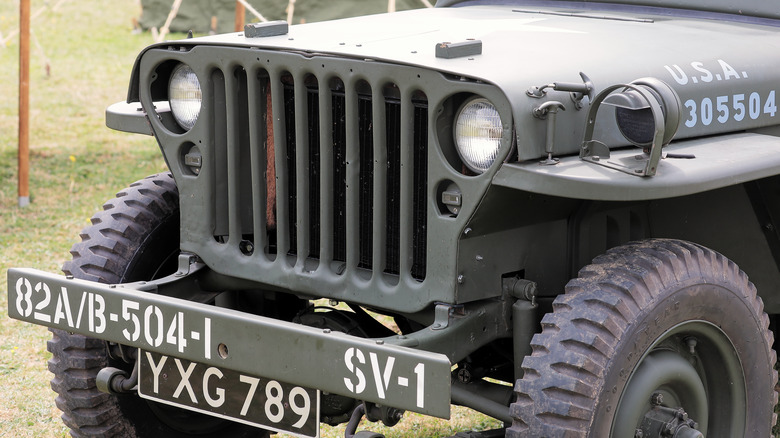Why Do Jeeps Have 7 Slots In The Grille? The History Behind The Signature Feature
The Jeep started off as a drab olive-green utility vehicle that drove troops into battle during World War II, but today it's as red, white, and blue as the flag of the United States. The stories that swirl around nearly every Jeep component are as mythical as the tales of Daniel Boone and Davy Crocket. From the Jeep name that may or may not stand for something to do with Popeye the Sailor Man to rules for a fun little game involving Jeeps and ducks and first-of-their-kind Easter eggs added to Jeeps, everything about this 4x4 makes it as genuinely American as the 4th of July and apple pie (sorry, Chevy). In fact, the Jeep might very well be the most American vehicle this country has ever produced.
You know you've created something legendary when others start ripping off your ideas. It's now an iconic brand of its own, but Toyota originally called its utility 4x4 LandCruiser a "Jeep." Imitation is, after all, the sincerest form of flattery. Right?
And let's not forget the famous seven-slotted front grille. What, you thought there wouldn't be a tale regarding the most aesthetically iconic emblem of the rough-and-tumble 4x4? So let's jump back in time to the very beginning of this four-wheeled wonder.
From the battlefield to the highway
When the military tossed out a request to 135 automakers for a "light reconnaissance" vehicle in June 1940, only three responded. Willys-Overland designed the Quad, later renamed the MA for Military model A and then the MB (Military model B), which had a welded flat iron "slat" radiator grille. American Bantam also submitted a prototype, and Ford supplied its GP Pygmy, which had a steel nine-slot grill. The Army settled on the nine-slot appearance and it became standardized on all models.
All manner of legends were born during its time on the battlefields of World War II. GIs were said to heat their rations on the exhaust manifold and drain the hot water from radiators to get a good, close shave. And chaplains reportedly used the Jeep's flat hood as an altar.
Once the war wrapped in 1945, the mighty military Jeep was adapted for civilian use and became the CJ-2A. One theory suggests Willys attempted to avoid a lawsuit from Ford by changing the grille ever so slightly from nine to seven, while another says it was simply the best-looking attempt at a total redesign.
But according to Stellantis, which currently owns Jeep, the answer is that one of the licensing requirements for the civilian Jeep was that it needed to have larger headlights than the military version. Thus, two radiator slots were removed to make room for the larger lamps, and the seven-slot grille was born.
It really is a Jeep thing
All of the CJ models after that featured the seven-slot grille. So did the FC series and Jeepster Commando (1966-1973). Other models, however, like the Wagoneer, Cherokee, and Willys Wagon, used anywhere from eight to 13 slots. Heck, the J10 Golden Eagle had 22 slots. But every single Jeep made since 1988 has only had seven adoring the front grille in some form or fashion.
Over the years, an endless array of offbeat fan theories and creative scuttlebutt have emerged regarding what the number seven might stand for. Perhaps it's a nod to its wartime heroics when it became the first vehicle to drive on all seven continents. Others feel it may be a reference to the seven wonders of the natural world ... or the seven pillars of wisdom, the seven seas, or even the number of colors in any given rainbow. If that doesn't float your boat, maybe it represents seven possible directions — up, down, right, left, forward, back, and center — alluding to the Jeep's ability to go anywhere at any time (that's actually a cool one, if you ask us).
You might be asking, so what's the deal with all of this unadulterated love for a slapped-together 4x4 built for built for WWII that turned into an automotive empire? Well, if you're asking that question, the brand's cheeky motto might be the best answer: "It's a Jeep thing. You wouldn't understand."


